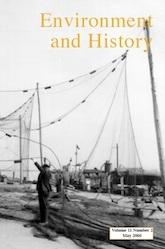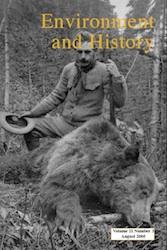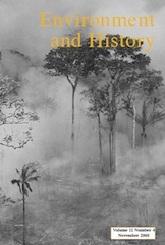Show search results for
"Deforestation, Forest Transitions, and Institutions for Sustainability in Southeastern Mexico, 1900–2000"
This paper aims (1) to contribute to a nuanced history of forest change in southeastern Mexico; and (2) to explore the role of institutional development in reducing deforestation rates.
"Antecedents to the Community Wildlife Conservation Programme in Kenya, 1946–1964"
While the evolution of community wildlife conservation in the country from the late 1970s tends to be portrayed as a programme without antecedents, this paper demonstrates that attempts to involve Africans in wildlife conservation in Kenya have a long history.
"Hunting Narratives of the Age of Empire: A Gender Reading of their Iconography"
The hunting-and-collecting mania of sportsmen from north-western Europe and the eastern United States is explored by focusing on the many hunting narratives that recount trips to the Canadian part of the Rocky Mountains and the Pacific Shore during the Age of Empire (1875–1914).
"The Last European Landscape to be Colonised: A Case Study of Land-Use Change in the Far North of Sweden 1850–1930"
The aim of this study was to analyse the swift land-use transition, from nomadic to agricultural, in the last colonised landscape of northern Sweden. Using historical documents and maps together with modern maps and a field survey, the authors wanted to link land-use patterns as strongly as possible to landscape features and ecosystems.
Smith, Alison K., "Public Works in an Autocratic State: Water Supplies in an Imperial Russian Town"
This paper traces the emergence in Russia of an interest in water as a public health issue from the 1830s and 1840s through to the modernising Great Reforms, when private interests helped bring older plans into reality.
"Working in the Mangroves and Beyond: Scientific Forestry and the Labour Question in Early Colonial Tanzania"
Germans arrived in Tanzania with a vision of scientific forestry derived from European and Asian templates of forest management that was premised on the creation of forest reserves emptied of human settlement. They found a landscape and human environment that was not amenable to established practices of rotational forestry.
"Was Brazilian Industrialisation Fuelled by Wood? Evaluating the Wood Hypothesis, 1900–1960"
Two substantive criticisms of Warren Dean’s ‘wood hypothesis’ are offered here: the wood hypothesis is accurate in general but underestimated the industrial consumption of fossil fuels, without conclusively rejecting the competing ‘hydroelectricity’ hypothesis; the method used for estimating potential energy supply from forest area was erroneous.
"A Dense and Sickly Mist from Thousands of Bog Fires: An Attempt to Compare the Energy Consumption in Slash-and-Burn Cultivation and Burning Cultivation of Peatlands in Finland in 1820–1920"
Burning cultivation of peatlands has been practised in peat-rich countries at one time or other throughout Western Europe. In these and other peat-rich countries, the inclusion of the emissions from burning cultivation could substantially alter historical carbon dioxide emission estimates.
"Reconciling Foreshore Development and Dune Erosion on Three Queensland Beaches: An Historical Perspective"
This paper examines the historical development of three beaches, and the subsequent implications for the beaches during the inevitable big seas and cyclones. This coastal environmental history informs local coastal communities about the importance of foresight in protecting dune systems in their natural state.




